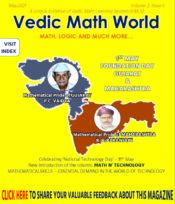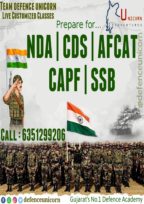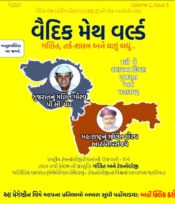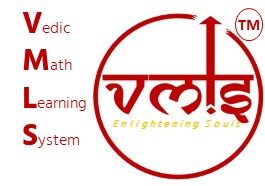MATHOPINION
INTELLECTUALS’ OPINION ABOUT MATHEMATICAL EDUCATION
ISSUES/EVENTS | PROBLEMS | CURRENT SCENARIO | SUGGESTED SOLUTIONS
(May2021)
DIGITAL CLASSROOMS HELP BRIDGE GAPS IN EXISTING EDUCATIONAL EXPERIENCE
MRS. POONAM SAXENA
Ex Programme Director
Khyati Foundation, Ahmedabad




SUBMIT YOUR ARTICLES AT vedicmathslearning@gmail.com FOR MATHOPINION COLUMN. REQUEST THE GUIDELINES FOR THE ARTICLE ON WHAT’S APP (M) 90 81 81 11 99.
DIGITAL CLASSROOMS HELP BRIDGE GAPS IN EXISTING EDUCATIONAL EXPERIENCE
MRS. POONAM SAXENA (Ex Programme Director , Khyati Foundation, Ahmedabad)
Published in May2021 issue of ‘VEDIC MATH WORLD’ – magazine
With the advent of internet in 1990s, internet-based learning (also referred to as distance learning) has made great strides. Many innovations from educators and technology have converged to make internet-based mathematics learning main stream. The virtual classes could be attended asynchronously by students, educator could be teaching a live class from thousands of miles away, educators could broadcast pre-made lesson/course videos to thousands of thousands at same time. Many institutions have supplemented in-person classes by on-line classes. This has become the predominant mode of teaching during the on-going pandemic.
Widespread internet access and reduced associated costs have allowed previously unconnected students to have access to better opportunities for education. Online programs have bridged geographies and brought specialized knowledge; to the rest of the world. Communities in rural and other under-served areas can now gain access to superior learning content through the internet. These classes can exist independently or in conjunction with the student’s own real-world classroom.
Teachers create content and share it on a digital platform through a live session or a pre-recorded session/module. Teaching in an online classroom provides greater career satisfaction as they have flexibility to connect with students at their own convenience and after their own real-world classes are done.
Education materials like documents, charts, pictures, videos, assignments, recorded sessions and various links that aid in understanding of a content, can be made accessible to the students at same time.
Students regardless of their location and time zones, and can access all the relevant learning material of the module at the same time, which can facilitate better and faster learning and bolster their existing educational experience. Similarly tests/quizzes, questionnaires are on-line and evaluation is instant using automated Software and performances can be evaluated, discussed and reviewed.
However, online learning has its own set of unique challenges as teaching learning environment is oral and text-based, which may result in a disinterested group of students. It is challenging for teacher to keep the students involved, attentive and responsive during the entire session.
For students to remain involved in an online class, the teachers have to put in real effort to create and maintain that spark of interest and inquisitiveness. If the content is not well planned, it is difficult to sustain student’s attention and focus for long sessions. The teachers’ expressions, language, clear and concise delivery, poor connect with the audience are some of the key reasons. It is especially true for subjects like mathematics, which are not intuitive and difficult to comprehend in the first place.
However, as with any new process or technology, certain challenges remain and require a creative approach for resolution. These primarily relate to unstable internet connections in India, many times it is difficult for students to participate in class discussions or to stay engaged throughout the duration of the session, teachers not being able to dynamically answer questions. This problem is further exacerbated for students who are working with loaner devices or not having right type of smart devices.
For queries, questions and to post responses students have resort to typing, which is much slower than speaking. It brings in the gap and reduces the attention span momentarily leading to disjointed understanding of subjects and concepts by students. This leads in interest depletion, that starts to impede the studies, resulting in procrastination of completion of a given task.
STEM classes are difficult than liberal arts because it is very different to learn coding or to see and do lab experiments in an online environment. STEM classes could mail kits with appropriate material forming partnerships with local universities and schools so students can get hands-on experience with equipment.
The challenges faced by the teachers may manifest itself in different ways which may be not be apparent in the beginning but are visible, over time and the students have to deal with the consequences. Because such classes do not offer equal learning value for all the students.
Personal relationships that teachers form with students are very difficult to forge in online classes, this is a huge loss. Hands-on learning, field visits and labs are big challenges, that cannot be practiced in online classes.
Being in a pastoral and academic role it becomes mandatory for a teacher to find disposition and the keenness of the students towards learning, in and out of the classroom and his way of seeing and engaging with the virtual classrooms.
Teachers need to constantly challenge themselves for improvement and supporting the students. This leads to teachers making ever increasing efforts to accomplish the desired learning outcomes.
Most of the logistical requirements associated with online learning have been simplified with the advent of applications and websites like Google Classroom, Zoom Canvas or Edmodo. These are used to upload videos, slides, assign projects and provide feedback on submitted assignments.
For online classes that are conducted live, the issues related to attention span, lack of dynamic response from the teacher, loss of group learning and socializing can be resolved by having digital break-out rooms for classes. The length of session can become a negative in both live and recorded sessions. It could remain close to 60 minutes with time for a 20 min break-out session. Limiting classroom size for these sessions will also be a key technique to ensure a good connection between the instructor and the learner.
Lack of adequate technology can be addressed through different partnership models. Institutions can provide students with ‘returnable’ devices, work with
corporate sponsors to donate working
but older equipment, and connect students with local libraries, schools and educational centres so they may use computer labs.
Ultimately, for most of the world, online education portals will take on supplemental role and a hybrid teaching – learning format would be best where classes are physical, providing better learning experience, interaction where total learning potential is supported by digital platforms.
The model is still evolving, and we as educators are learning and adapting, to best meet the needs of students.
SUBMIT YOUR ARTICLES AT vedicmathslearning@gmail.com FOR MATHOPINION COLUMN. REQUEST THE GUIDELINES FOR THE ARTICLE ON WHAT’S APP (M) 90 81 81 11 99.
